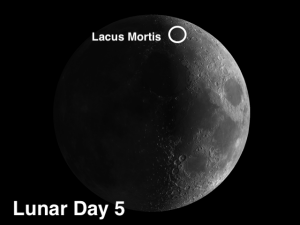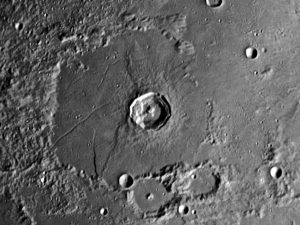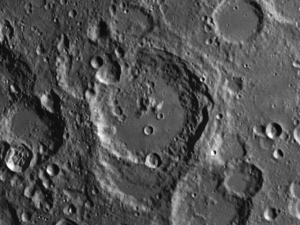 The week of May 6-12 takes us from lunar Day 2 to Day 8. This week we will highlight the charmingly named Lacus Mortis (the Lake of Death) and Bürg, two craters viewable on Thursday evening, and the crater Maurolycus, viewable on Friday evening.
The week of May 6-12 takes us from lunar Day 2 to Day 8. This week we will highlight the charmingly named Lacus Mortis (the Lake of Death) and Bürg, two craters viewable on Thursday evening, and the crater Maurolycus, viewable on Friday evening.
 Lacus Mortis: [NE/E12] This is a large lava-flooded crater (90 miles in diameter) just north of Mare Serenitatis which contains rilles, wrinkle ridges, faults, and a substantial internal crater, Bürg. At more than four billion years, Lacus Mortis is one of the oldest impact features on the Moon. The principal rille, Rima Bürg, is 60 miles long and can be seen through small telescopes. Another rille starts halfway between Bürg and the rim of the Lacus and goes straight south. In the process, it changes from a generic rille to a genuine fault whose floor falls away on the western side. Can you make out where the rille ends and the fault begins? At sunrise you will see a shadow extending to the west, and at sunset (around Day 19) the face of the fault is brightly illuminated. Make a quick sketch of Lacus Mortis, then come back later and see if you can add more detail.
Lacus Mortis: [NE/E12] This is a large lava-flooded crater (90 miles in diameter) just north of Mare Serenitatis which contains rilles, wrinkle ridges, faults, and a substantial internal crater, Bürg. At more than four billion years, Lacus Mortis is one of the oldest impact features on the Moon. The principal rille, Rima Bürg, is 60 miles long and can be seen through small telescopes. Another rille starts halfway between Bürg and the rim of the Lacus and goes straight south. In the process, it changes from a generic rille to a genuine fault whose floor falls away on the western side. Can you make out where the rille ends and the fault begins? At sunrise you will see a shadow extending to the west, and at sunset (around Day 19) the face of the fault is brightly illuminated. Make a quick sketch of Lacus Mortis, then come back later and see if you can add more detail.
Bürg: [NE/E12] The centerpiece of Lacus Mortis is the 25-mile crater Bürg, a complex crater with terraces and a central mountain peak that appears to be split in two. As far as complex craters go, Bürg is a bit unusual. Instead of being mostly circular, the rim is scalloped and wavy and there is an inordinate amount of slumping on the western interior slopes; a finger of the slumping actually touches the central mountain peak! Some observers have reported a small summit pit on the top of the central mountain. Can you make it out?
 Maurolycus: [SE/P11] Let us venture briefly into a region where angels fear to tread, the lunar Highlands. Plunge in and look for the crater Maurolycus. Although the area looks confusing, Maurolycus will be the largest and most conspicuous crater in this sector. It is a breathtaking sight under an early morning Sun and should not be missed.
Maurolycus: [SE/P11] Let us venture briefly into a region where angels fear to tread, the lunar Highlands. Plunge in and look for the crater Maurolycus. Although the area looks confusing, Maurolycus will be the largest and most conspicuous crater in this sector. It is a breathtaking sight under an early morning Sun and should not be missed.
Maurolycus displays a rich diversity of different types of features. How many can you see? The central mountain peaks are so tall that they are illuminated long before the Sun finds its way to the dark floor. Also notice how Maurolycus overlaps a smaller unnamed crater on its southern border. This flies in the face of the rule that says younger craters are usually smaller than their older bretheren.
WHAT’S HOT ON THE MOON TONIGHT … AND THIS WEEK:
For those who are new to this blog, the author has written a book on observing the Moon entitled What’s Hot on the Moon Tonight? The Ultimate Guide to Lunar Observing. It is a nightly guide to the Moon’s most interesting features as they are revealed throughout the lunar month. It is highly recommended that you obtain Sky & Telescope’s Field Map of the Moon. Lunar features that are described in the book are keyed to the grid in the Field Map.
I was fortunate in that Charles Wood, author of The Modern Moon: A Personal View, a writer for Sky & Tel, and the country’s leading authority on lunar observing was willing to write the foreword. The book is available on Amazon and from my website, AndrewPlanck.com. (If you would like a signed copy, please order from my website.)
An e-book version of What’s Hot is now available on iTunes and Amazon. An additional feature is that in the e-book version the longitude of lunar objects has been added to the grid reference, e.g., Plato: [NW/D9; L=9°W], meaning open the Field Map to the NW quadrant, grid D9; Plato is at longitude 9°W. The longitude of a feature is enormously helpful when you are planning a night’s observation because any object which is within 15° or so of the terminator will stand out with astonishing detail!1
1 To find out what the longitude of the terminator will be for any night, download the free Virtual Moon Atlas onto your computer. Set the date to the night you wish to observe, then click on a crater on the terminator and read its longitude. Or use the Moon Map Pro app if you are lucky enough to have gotten it before it became unavailable on iTunes.
======================
It is highly recommended that you get a copy of Sky and Telescope’s Field Map of the Moon, the very finest Moon map available for use at the telescope. It is available for $10.95 at www.skyandtelescope.com and on Amazon. All features mentioned in this blog will be keyed to the grid on the Field Map and will look like this: Plato: [NW/D9]
Credits:
Courtesy of Gray Photography of Corpus Christi, Texas
Lunar photos: NASA / USGS / BMDO / LROC / ASU / DLR / LOLA / Moon Globe. Used by permission
- Rupes Cauchy: A Best Known Fault on the Moon - July 22, 2024
- Moon Crater Schickard – Crater Floor has Stripes - July 15, 2024
- Moon Craters Langrenus and Vandelinus - July 8, 2024
TO Andrew Planck.
I really like your lunar information, the night sky over England has been overcast for the last month
leaving no chance to do any lunar observing .
I will be ordering the lunar map soon.